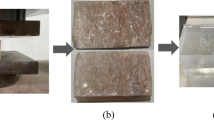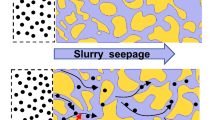Abstract
The plurigaussian model is used in mining engineering, oil reservoir characterization, hydrology and environmental sciences to simulate the layout of geological domains in the subsurface, while reproducing their spatial continuity and dependence relationships. However, this model is well-established only in the stationary case, when the spatial distribution of the domains is homogeneous in space, and suffers from theoretical and practical impediments in the non-stationary case. To overcome these limitations, this paper proposes extending the model to the truncation of intrinsic random fields of order k with Gaussian generalized increments, which allows reproducing spatial trends in the distribution of the geological domains. Methodological tools and algorithms are presented to infer the model parameters and to construct realizations of the geological domains conditioned to existing data. The proposal is illustrated with the simulation of rock type domains in an ore deposit in order to demonstrate its applicability. Despite the limited number of conditioning data, the results show a remarkable agreement between the simulated domains and the lithological model interpreted by geologists, while the conventional stationary plurigaussian model turns out to be unsuccessful.








Similar content being viewed by others
References
Armstrong M, Galli A, Beucher H, Le Loc’h G, Renard D, Renard B, Eschard R, Geffroy F (2011) Plurigaussian simulations in geosciences. Springer, Berlin
Arroyo D, Emery X (2015) Simulation of intrinsic random fields of order k with Gaussian generalized increments by Gibbs sampling. Math Geosci 47(8):955–974
Arroyo D, Emery X (2016) Spectral simulation of vector random fields with stationary Gaussian increments in d-dimensional Euclidean spaces. Stoch Environ Res Risk Assess. doi:10.1007/s00477-016-1225-7
Arroyo D, Emery X, Peláez M (2012) An enhanced Gibbs sampler algorithm for non-conditional simulation of Gaussian random vectors. Comput Geosci 46:138–148
Bernstein DS (2009) Matrix mathematics. Princeton University Press, Princeton
Beucher H, Galli A, Le Loc’h G, Ravenne C (1993) Including a regional trend in reservoir modeling using the truncated Gaussian method. In: Soares A (ed) Geostatistics Tróia’92. Kluwer Academic, Dordrecht, pp 555–566
Biver P, Haas A, Bacquet C (2002) Uncertainties in facies proportion estimation II: application to geostatistical simulation of facies and assessment of volumetric uncertainties. Math Geol 34(6):703–714
Chilès JP, Delfiner P (2012) Geostatistics: modeling spatial uncertainty. Wiley, New York
Christakos G (1992) Random field models in earth sciences. Academic Press, San Diego
Delfiner P (1976) Linear estimation of nonstationary spatial phenomena. In: Guarascio M, David M, Huijbregts CJ (eds) Advanced geostatistics in the mining industry. Reidel, Dordrecht, pp 49–68
Emery X (2007) Simulation of geological domains using the plurigaussian model: new developments and computer programs. Comput Geosci 33(9):1189–1201
Emery X (2008) Uncertainty modeling and spatial prediction by multi-Gaussian kriging: accounting for an unknown mean value. Comput Geosci 34(11):1431–1442
Emery X (2010) Iterative algorithms for fitting a linear model of coregionalization. Comput Geosci 36(9):1150–1160
Emery X, Cornejo J (2010) Truncated Gaussian simulation of discrete-valued, ordinal coregionalized variables. Comput Geosci 36(10):1325–1338
Emery X, Lantuéjoul C (2006) TBSIM: a computer program for conditional simulation of three-dimensional Gaussian random fields via the turning bands method. Comput Geosci 32(10):1615–1628
Emery X, Lantuéjoul C (2008) A spectral approach to simulating intrinsic random fields with power and spline generalized covariances. Comput Geosci 12(1):121–132
Emery X, Arroyo D, Peláez M (2014) Simulating large Gaussian vectors subject to inequality constraints by Gibbs sampling. Math Geosci 46:265–283
Galli A, Beucher H, Le Loc’h G, Doligez B (1994) The pros and cons of the truncated Gaussian method. In: Armstrong M, Dowd PA (eds) Geostatistical simulations. Kluwer, Dordrecht, pp 217–233
Geman S, Geman D (1984) Stochastic relaxation, Gibbs distributions, and the Bayesian restoration of images. IEEE Trans Pattern Anal Mach Intell 6:721–741
Guilbert JM, Park CF (1986) The geology of ore deposits. Freeman, New York
Langlais V, Beucher H, Renard D (2008) In the shade of truncated Gaussian simulation. In: Ortiz JM, Emery X (eds) Proceedings of the eighth international geostatistics congress. Gecamin Ltda, Santiago, pp 799–808
Lantuéjoul C (2002) Geostatistical simulation, Models and Algorithms. Springer, New York
Lantuéjoul C, Desassis N (2012) Simulation of a Gaussian random vector: a propagative version of the Gibbs sampler. In: Ninth international geostatistics congress, Oslo
Le Loc’h G, Galli A (1997) Truncated plurigaussian method: theoretical and practical points of view. In: Baafi EY, Schofield NA (eds) Geostatistics Wollongong’96. Kluwer Academic, Dordrecht, pp 211–222
Lowell JD, Guilbert JM (1970) Lateral and vertical alteration-mineralization zoning in porphyry ore deposits. Econ Geol 65:373–408
Madani N, Emery X (2015) Simulation of geo-domains accounting for chronology and contact relationships: application to the Río Blanco copper deposit. Stoch Environ Res Risk Assess 29:2173–2191
Matheron G (1971) The theory of regionalized variables and its applications. Ecole Nationale Supérieure des Mines de Paris, Fontainebleau, p 212
Matheron G (1973) The intrinsic random functions and their applications. Adv Appl Probab 5(3):439–468
Ravenne C, Galli A, Doligez B, Beucher H, Eschard R (2002) Quantification of facies relationships via proportion curves. In: Armstrong M, Bettini C, Champigny N, Galli A, Remacre A (eds) Geostatistics Rio 2000. Kluwer Academic, Dordrecht, pp 19–40
Serrano L, Vargas R, Stambuk V, Aguilar C, Galeb M, Holmgren C, Contreras A, Godoy S, Vela I, Skewes MA, Stern CR (1996) The late Miocene to early Pliocene Río Blanco-Los Bronces copper deposit, Central Chilean Andes. In: Camus F, Sillitoe RH, Petersen R (eds) Andean copper deposits: new discoveries, mineralization, styles and metallogeny. Special publication No. 5. Society of Economic Geologists, Littleton, p 119
Skewes MA, Stern CR (1995) Genesis of the late Miocene to Pliocene copper deposits of central Chile in the context of Andean magmatic and tectonic evolution. Int Geol Rev 37(10):893–909
Stambuk V, Aguilar C, Blondel J, Galeb M, Serrano L, Vargas R (1988) Geología del yacimiento Río Blanco. Technical Report. Codelco-Chile, División Andina
Stein ML (2002) Fast and exact simulation of fractional Brownian surfaces. J Comput Graph Stat 11(3):587–599
Xu C, Dowd PA, Mardia KV, Fowell RJ (2006) A flexible true plurigaussian code for spatial facies simulations. Comput Geosci 32(10):1629–1645
Acknowledgements
This research was funded by the Chilean Commission for Scientific and Technological Research, through projects CONICYT/FONDECYT/REGULAR/No 1130085 and CONICYT PIA Anillo ACT1407. The authors also acknowledge the support from Mr. Claudio Martínez from Codelco-Chile (Andina Division), who provided the data set used in this work.
Author information
Authors and Affiliations
Corresponding author
Rights and permissions
About this article
Cite this article
Madani, N., Emery, X. Plurigaussian modeling of geological domains based on the truncation of non-stationary Gaussian random fields. Stoch Environ Res Risk Assess 31, 893–913 (2017). https://doi.org/10.1007/s00477-016-1365-9
Published:
Issue Date:
DOI: https://doi.org/10.1007/s00477-016-1365-9




